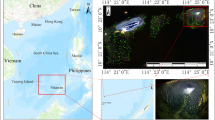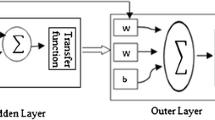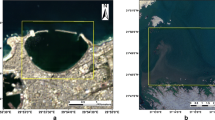Abstract
Water depth is an essential element of oceanographic research and marine surveying. Bathymetry inversion based on remote sensing is a time-effective, low-cost, and wide-coverage solution for shallow sea. Using WorldViewII multi-spectral remote sensing imagery and laser sounding data, Back Propagation neural network model (BP), random forest model (RF) and extreme learning machine model (ELM) were used to inverse water depth Surrounding the Chinese Ganquan island, and the inversion accuracy was compared and evaluated. The results show that among the BP, RF and ELM, the RF has the highest water depth inversion accuracy. The root mean square error (RMSE) of the check point is 0.85, the mean absolute error (MAE) is 0.60, and the mean relative error (MRE) is 3.54%. The coefficient determination R2 reaches 0.97; within the range of 0–10 m and 15–20 m water depth, the inversion of the ELM is the best; in the range of 10–15 m water depth, the RF has the better inversion effect.
Access this chapter
Tax calculation will be finalised at checkout
Purchases are for personal use only
Similar content being viewed by others
References
Shao, S.: Research on shallow water depth extraction of the GF-satellite remote sensing. Harbin Engineering University (2019)
Zhang, L., Mou, X.Y., Ji, H.L.: Research on water depth inversion in reservoir area based on multi band remote sensing data. J. Hydraulic Eng. 49(5), 639–647 (2018)
Cao, B., Qiu, Z.G., Cao, B.C.: Comparison among four inverse algorithms of water depth. J. Geomat. Sci. Technol. 4, 388–393 (2016)
Lyzenga, D.R.: Passive remote sensing techniques for mapping water depth and bottom features. Appl. Opt. 17(3), 379 (1978)
Stumpf, R.P., Sinclair, M.: Determination of water depth with high-resolution satellite imagery over variable bottom types. Limnol. Oceanogr. 48(1), 547–556 (2003)
Wang, J.J., Tian, Q.J.: Study on shallow coastal water depth derived method based on hyperspectral remote sensing. Sci. Geogr. Sinica 6, 843–848 (2007)
Sandidge, J.C., Holyer, R.J.: Coastal Bathymetry from Hyper-spectral Observation of Water Radiance. Remote Sens. Environ. 65(3), 341–352 (1998)
Anctil, F., Coulibaly, P.: Wavelet analysis of the interannual variability in southern Quabec streamflow. J. Clim. 17(1), 163–173 (2004)
Deng, Z.D., Ye, X., Guan, H.J.: Remote sensing of water depth based on RBF neural network. J. PLA Univ. Sci. Technol. 14(1), 101–106 (2017)
Zheng, G.Z., Le, X., Wang, H.P.: Inversion of water depth from WorldView-02 satellite imagery based on BP and RBF neural network. Earth Sci. 42(12), 2345–2353 (2017)
Wang, Y.J., Zhang, Y.: Study on remote sensing of water depth based on bp artificial neural networks. Ocean Eng. 4, 37–42 (2005)
Liu, Y.L.: A review of random forest. Nankai University, Tian Jin (2008)
Huang, G.B, Zhu, Q.Y., Siew, C.K.: Extreme learning machine: a new learning scheme of feedforward neural networks (2005)
Eshtay, M., Faris, H., Obeid, N.: Improving extreme learning machine by competitive swarm optimization and its application for medical diagnosis problems. Expert Syst. Appl. 104, 134–152 (2018)
Cao, W., Ming, Z., Wang, X.: Improved bidirectional extreme learning machine based on enhanced random search. Memet. Comput. 11(5), 1–8 (2017)
Wu, Z.Q., Mao, Z.H., Wang, Z.: Research on remote sensing inversion of shallow water depth based on extreme learning machine. Hydrogr. Surv. Chart. 39(3), 11–15 (2019)
Wang, X.C., Shi, F., Yu, L.: 43 Cases of MATLAB Neural Network Analysis. Beijing University of Aeronautics and Astronautics Press, BeiJing (2013)
Author information
Authors and Affiliations
Corresponding author
Editor information
Editors and Affiliations
Rights and permissions
Copyright information
© 2021 The Editor(s) (if applicable) and The Author(s), under exclusive license to Springer Nature Switzerland AG
About this paper
Cite this paper
Wei, S., Qian, J., Yali, R., Ran, M. (2021). Comparative Study of Different Machine Learning Models for Remote Sensing Bathymetry Inversion. In: Kahraman, C., Cevik Onar, S., Oztaysi, B., Sari, I., Cebi, S., Tolga, A. (eds) Intelligent and Fuzzy Techniques: Smart and Innovative Solutions. INFUS 2020. Advances in Intelligent Systems and Computing, vol 1197. Springer, Cham. https://doi.org/10.1007/978-3-030-51156-2_133
Download citation
DOI: https://doi.org/10.1007/978-3-030-51156-2_133
Published:
Publisher Name: Springer, Cham
Print ISBN: 978-3-030-51155-5
Online ISBN: 978-3-030-51156-2
eBook Packages: Intelligent Technologies and RoboticsIntelligent Technologies and Robotics (R0)




